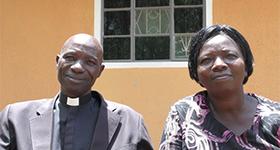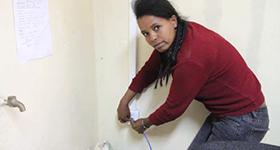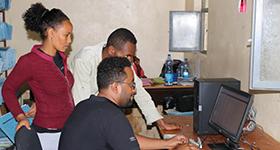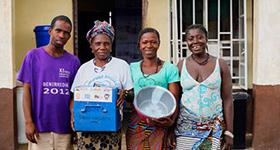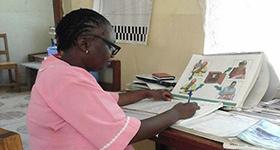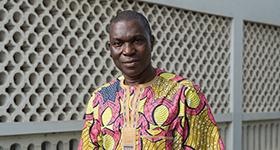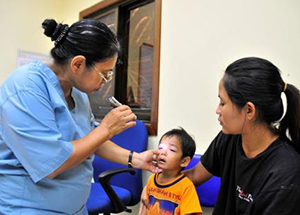
Photo: Ms. Channy, AHC refraction nurse, conducts a preliminary diagnosis of Sok Samaky’s eye health. This grant supported additional training for Ms. Channy, improving her ability to diagnose and manage eye diseases in children.
Background
With the support of USAID’s Childhood Blindness Grant, Seva Foundation was able to continue their work with pediatric ophthalmology in Nepal and Cambodia. Seva Foundation contributed to building the Angkor Hospital for Children’s (AHC) capacity to provide pediatric eye care, improved the clinical diagnosis of eye disease and expanded community outreach programs in Cambodia.
Intervention
To increase awareness of eye care knowledge in the community and to connect children with needed services, Seva trained Cambodian school teachers and health center staff in primary eye care and visual acuity screening. The trained teachers then conducted screenings at their local schools and referred children with refractive errors to Mrs. Channy, a refraction nurse at AHC who was trained with support from USAID. In addition, other health center staff in Siem Reap, learned about primary eye care, childhood blindness and how to refer children who need additional eye care.

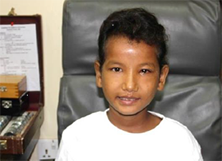
Photo: Top: Srey Leak’s left eye diagnosed with Strabismus. Bottom: Srey Leak after undergoing a successful strabismus surgery.
Outcome
Srey Leak, 11 years old, is one of the children who has benefited from the efforts of this project. Srey lives with her parents at Prek Norin Commune in Battambang province about 200 km from Angkor Hospital for Children (AHC). Srey had blurry vision since birth due to Strabismus. Day to day, Srey experienced chronic headaches from her blurred vision. She had difficulty studying and struggled in school. After school, during the evening hours, Srey needed to be extra cautious when doing any activity because of her nighttime blindness. Srey’s parents never knew their daughter could avoid this suffering.
Fortunately, the Battambang school screening program supported by USAID, identified Srey during a screening at her school and referred her to AHC. Shortly thereafter, Srey had a successful surgery, correcting her left eye. The cost of the surgery was supported in part by USAID. Now she is back in school and more confident than ever. Srey would have lived her entire life with blurred vision and disabling headaches if it were not for the school screenings and free of cost of care at AHC

